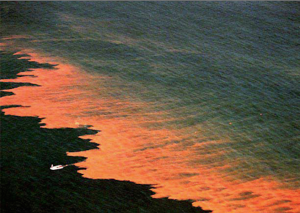
Domoic acid or “Red Tide” is produced by algae and accumulates in shellfish, sardines, and anchovies which are then eaten by marine mammals, cetaceans, and even humans. Exposure to the biotoxin can affect the brain, causing the affected individual to become lethargic, disoriented, and even prone to seizures (5). A wildly, exaggerated depiction of the effects of domoic acid was presented in the movie “The Birds” by Alfred Hitchcock; a fictional but certainly interesting portrayal of human-wildlife interactions (4).
Although this phenomenon is not just the making of a terrifying thriller, hazardous levels of domoic acid have been linked to warmer ocean conditions in waters off Oregon and Washington through research by the National Oceanic and Atmospheric Administration (NOAA) in the US (3). The timing of elevated domoic acid is strongly related to warm phases of Pacific Decadal Oscillation and the Oceanic Niño Index, an indicator of El Niño events (1). Organisms such as plankton are indicators of water mass transport during oscillations between warm and cool regimes (3). El Niño events as pictured in the image below account for warmer, wetter conditions as anomalously warm water masses are pushed onto the continental shelf, and are hypothesized to cause increases in the domoic toxin.

With the intensity of El Niño events occurring with global climate change, this is a timely issue especially when considering the demand of viable shellfish industries. Toxic algae blooms have occurred off the coasts of Norway, Chile, Canada, the U.S., Japan, New Zealand, India, Spain, China, and many other countries with often severe impacts to the fish and shellfish industries (6). Substantial economic losses can result from these algal blooms with closed fisheries, decreased demand, and human illness. The work of the climatic regulation study (1) to help determine the increased climate-ocean variability will help predict the events of domoic acid outbreaks and help monitor human health thresholds for shellfish (3).

Domoic acid effects can be seen throughout the entire food web, where domoic acid events have been linked to mass death of marine mammals such as sea otters, sea lions, dolphins, and whales (5). The toxin concentrates its way up the food chain and causes seizures as the toxin targets the brain.
Essentially, if warmer conditions are more persistent with global climate change, the probability and severity of domoic acid events will increase. The more likely these domoic acid thresholds will be surpassed, the more likely shellfish industries will be put at risk as well as the sustainability of marine organisms. The way we manage shellfish industries may need to be considered more closely to take into account the inherent risks of domoic acid events.
References:
- McKibben, S.M., Peterson, W., Wood, A.M., Trainer, V.L., Hunter, M., & White, A. E. (2016). Climatic regulation of the neurotoxin domoic acid. Proceedings of the National Academy of Sciences of the United States of America, 114 (2): 239-244. doi: 10.1073/pnas.1606798114.
- National Oceanic and Atmospheric Administration. (n.d.). El Niño theme page: Pacific Marine Environmental Laboratory. Retrieved from: http://www.pmel.noaa.gov/elnino/faq#what.
- National Oceanic and Atmospheric Administration. (2017). Warmer West Coast ocean conditions linked to an increased risk of toxic shellfish: NOAA, Oregon State University provide new tools to predict harmful algae blooms. Retrieved from: http://www.noaa.gov/media-release/warmer-west-coast-ocean-conditions-linked-to-increased-risk-of-toxic-shellfish.
- Parry, W. (2012). Blame Hitchcock’s crazed birds on toxic algae. Retrieved from: http://www.livescience.com/17713-hitchcock-birds-movie-algae-toxin.html.
- The Marine Mammal Centre. c2017. Domoic Acid Toxicity. (accessed February 9, 2017). Retrieved from: http://www.marinemammalcenter.org/science/top-research-projects/domoic-acid-toxicity.html.
- Wessells, C.R., Miller, C.J., & Brooks, P.M. (1995). Toxic algae contamination and demand for shellfish: A case study and demand for mussels in Montreal. Marine Resource Economics, 10, pp. 143-159.